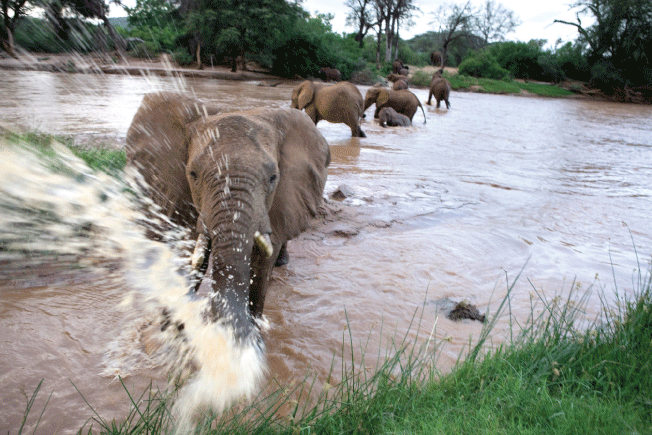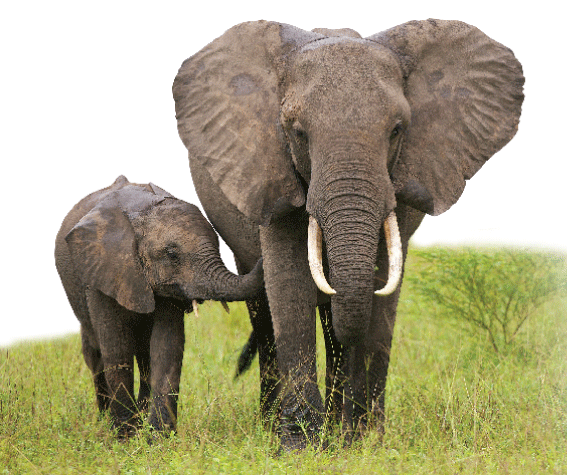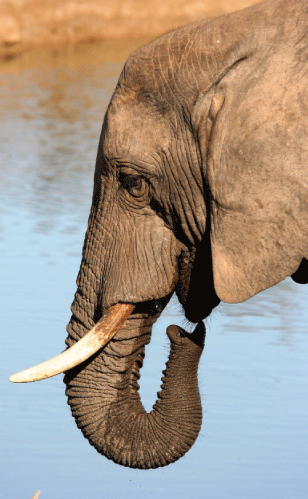
The Problem with Elephants
 |
By Boyd Matson
Any clear-thinking person would be yelling, "Hurry, faster, let's get out of here." Instead, I hear myself saying, "Stop! You're ruining the shot."
Apparently the years have scrambled my prefrontal cortex synapses, limiting my ability to recognize the danger posed by an angry, charging, six-ton elephant fed up with my picture taking. Fortunately, Mike Hax, my guide and driver, sees the potential for an ugly Russell-Crowe-meets-the-paparazzi incident and keeps our vehicle in high-speed reverse.
We're in East Africa, in Kenya's Masai Mara for the annual wildlife migration. For photos, the best action takes place at the river crossings. Massive herds of wildebeest and zebra with the unwavering belief that the grass is always greener on the other side leap from riverbanks into crocodile-infested waters. These predator-prey encounters are centerfold material for National Geographic magazine – but can become humdrum when viewed relentlessly.
That's why I prefer watching elephants. The biggest land animals on the planet spend up to three-fourths of their day eating 250 to 500 pounds of vegetation washed down with some 50 gallons of water. "Where's the excitement in that?" you might ask. The answer lies in the trunk.
Like a Leatherman multipurpose tool for a backpacker, an elephant's trunk is a portable, all-in-one appendage. Need to breathe? The trunk's a nose. Need to grab a high branch? It's an arm. Need to pick up a morsel of food? It's a hand. Need a drink? It's a straw. Need a shower? It's a hose. Want attention? It's a trumpet. The trunk can even serve as a third ear, detecting the vibrations of distant noises traveling through the ground.
I learned firsthand about the wonders of the elephant trunk on my first trip to Africa 17 years ago. Wildlife filmmaker Dereck Joubert was using a steadicam to film a group of male elephants drinking at a watering hole in Botswana. The plan was to approach the elephants with the camera rolling. The steadicam is a heavy harness with a gyroscope that takes the bounce and jiggle out of a shot while you move with the camera. But the extra weight makes it hard to walk, especially on the pockmarked mud around a watering hole. My job was to lend Dereck a hand so he didn't trip and fall. In his words, "That would be trouble because it could startle the elephants into charging us."
"Should we really be worried?" I asked.
"Of course," he answered, adding, "but if it weren't a little dangerous, it wouldn't be worth doing."
As we slowly moved toward the herd, I felt like we were a couple of strangers. I thought the elephants would charge. Dereck believed they would simply leave. They did neither. They just stood and drank, ignoring us until we were almost at the water's edge. Then one of the older elephants pointed his trunk in our direction and announced "That's far enough, boys" by spraying us with a couple of gallons of pond water.
I laughed with relief, the tension broken.
Three years ago I was back in Botswana at a different watering hole just before sunset when four young male elephants and two older females decided to throw an impromptu pool party. The guys were having a water fight, rolling around, splashing, hitting the water with their trunks, jumping on each other's backs, and pushing one another's heads underwater.
But the highlight was a maneuver I'd not seen before. A couple of them, acting like trained performers, sat up on their rear ends, lifted their front legs, and slapped the surface of the water to splash themselves, all the while spinning their trunks up in the air above their heads. The show lasted for almost an hour. That memorable performance is why I always prefer to go watch the elephants when I hear they're playing at a nearby watering hole.
But the show that elephants put on away from the water – again, thanks to their trunks – also never ceases to amaze me. And that's what I'm watching on this trip to the Masai Mara. The two "fingers" on the end of the trunk have enough dexterity to pick up a single blade of grass, yet the trunk also has the strength to lift a 600-pound log. Elephants use their trunks to touch, stroke, caress and greet each other. They can also use them like weapons to wield power and dispense discipline. And yet while watching elephants do all of these things, I can't help but think how these giant, intelligent, charismatic creatures have one disastrous design flaw: They have ivory tusks.
Actually, the flaw is ours. We humans have such an irrational desire for ivory jewelry and carvings that we have effectively transformed the tusk from a tool the elephant needs for survival into an expensive commodity that threatens the animal's very existence. Our desire for trinkets has put a price on the head of every elephant in Africa.
For a few years the ivory trade was completely banned, but as elephant populations stabilized in some countries, exceptions were made, limited trade of stockpiled ivory allowed. As a result, elephant poaching is again a big business. According to some estimates, poachers are killing more than 35,000 elephants a year for their tusks.
I finish my visit to the elephants in Kenya this year with a stop at the David Sheldrick Wildlife Trust at its Nairobi National Park facility. Here the trust takes in orphaned baby elephants whose mothers have been killed.
It's almost impossible to successfully hand-raise a newly born milk-dependent African elephant. The Sheldrick Wildlife Trust was the first to do it. Elephants are so family-oriented that each orphan has to have a handler acting as surrogate mom, living with it 24/7, including sleeping in the same stall and waking up every three hours to bottle-feed the baby. It's a slow, labor-intensive process. In the past 24 years, the trust has saved, laudably, 130 elephants, but that's a drop in the bucket compared to the thousands murdered each year.
You can help by sponsoring an orphan for $50 bucks, which allows you to visit the babies. And if an orphan extends its trunk to sniff you or check out what's in your pockets, you'll see how some 100,000 muscle fascicles work together to create one of nature's most interesting and complex body parts. You might begin to appreciate how I can spend hours just watching elephants eat. But one thing you will never understand is how all the ivory trinkets in the world could be worth the life of even one elephant.